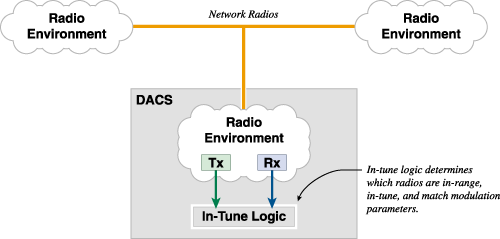

The DACS identifies which radios are in-tune and in-range, from their basic parameters.


The DACS generates a Terrain PDU that contains location data for each Tx/Rx radio, which is then output via the DACS "Host" interface.

The Host system database server (often the visual system) is interrogated to determine whether any terrain (mountains, hills, curvature of the Earth, etc.) blocks the transmission path. The DACS waits for a response.

The database server returns a path factor between the specific locations of the transmitter and receiver to the host. The host then returns the original PDU to the DACS after adding a computed path factor value.

The DACS receives the Terrain PDU complete with computed path factor value (typically, this is set to 1.0 for no loss, or 0.0 for total loss when blocked by terrain).
